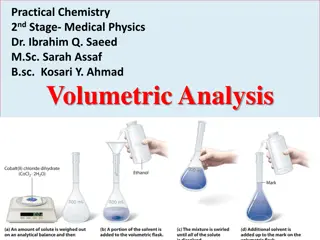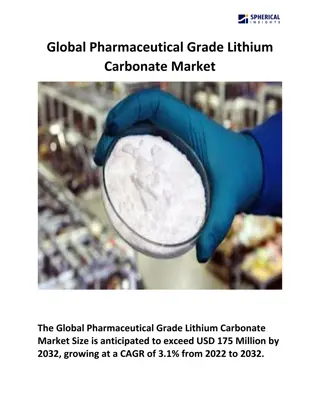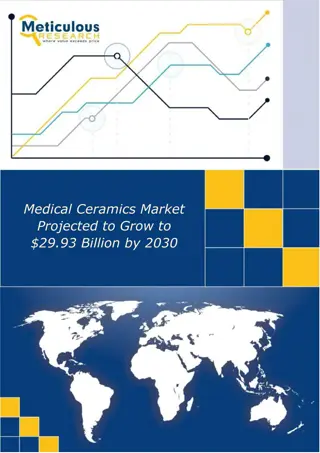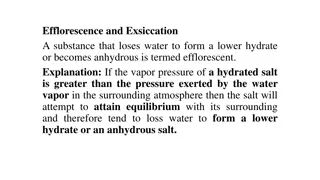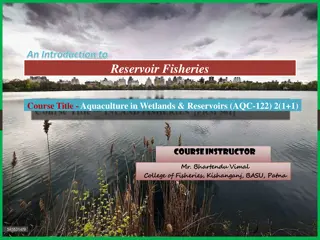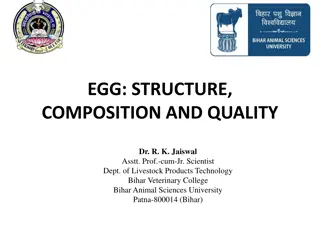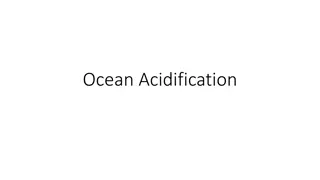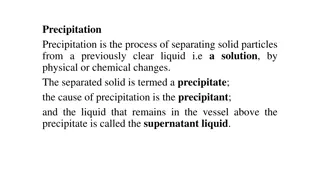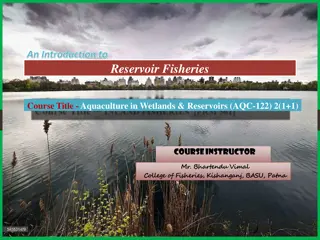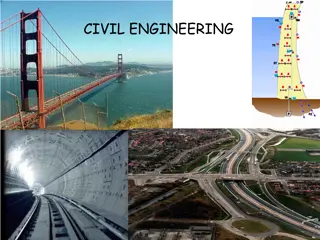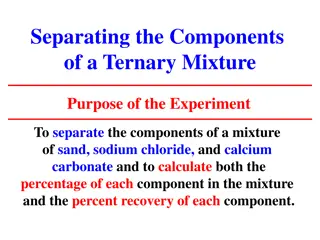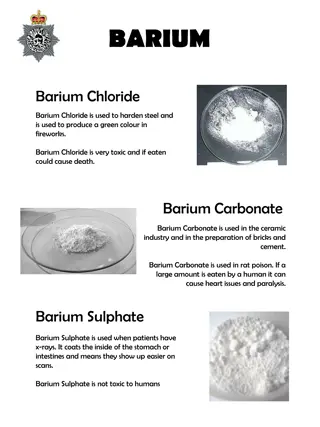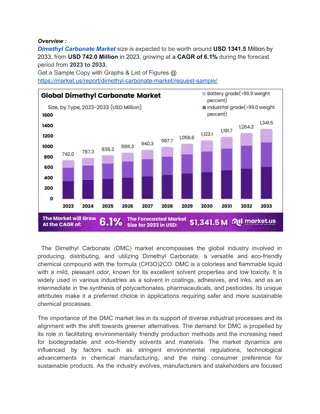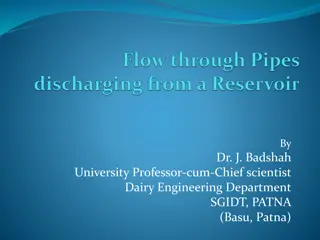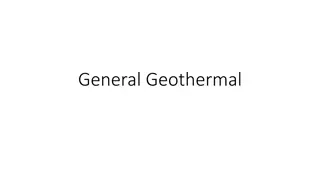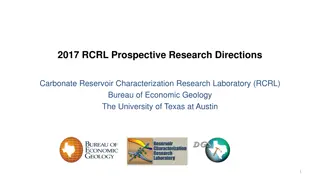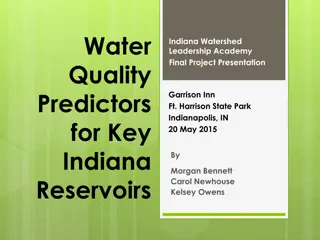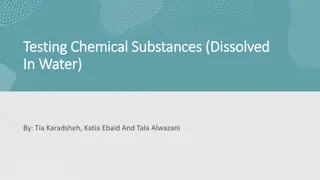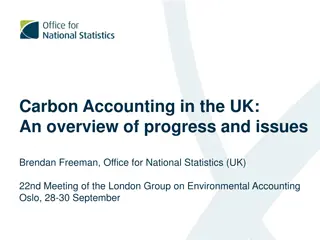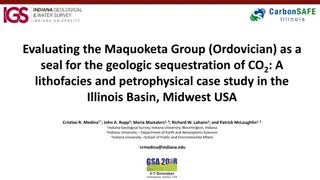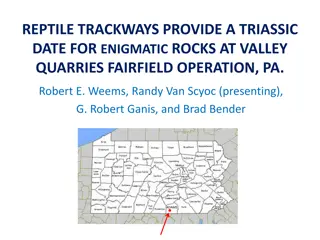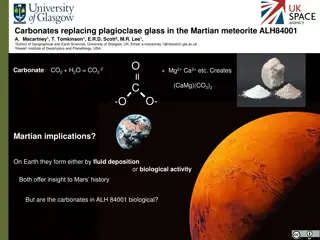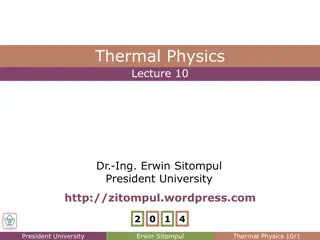Titration Colour Changes
This collection features various experiments in chemistry involving titration and solutions. It includes procedures such as standardizing hydrochloric acid using sodium carbonate, titrating hydrochloric acid with sodium hydroxide to produce sodium chloride, determining the concentration of ethanoic
0 views • 10 slides
ASPEN Staged Separation Unit-Ops
Introduction to Aspen Staged Separation Unit Operations for the purification of desired components by removing impurities and pollutants using distillation, absorption, and stripping columns. This technology is relevant to ammonia synthesis to prevent catalyst poisoning by removing CO2 through absor
0 views • 26 slides
Understanding the Carbon Cycle: Reservoirs, Dynamics, and Importance
Earth's carbon cycle plays a crucial role in sustaining life, with carbon moving through various reservoirs and processes. This cycle involves short-term terrestrial and marine cycles, as well as long-term cycles influenced by volcanic activity and rock weathering. Understanding carbon reservoir dyn
6 views • 45 slides
Understanding the Role of Phosphatase Enzymes in Metabolic Reactions
Phosphatase enzymes play a crucial role in various metabolic processes by releasing phosphate groups, increasing their availability for energy synthesis and cell structure formation. Acid phosphatases, with an optimum pH below 7.0, can be extracted from plant tissues like germinating mung beans. A p
7 views • 34 slides
Volumetric Analysis Experiment: Standardization of Hydrochloric Acid Using Sodium Carbonate
In this experiment, hydrochloric acid (HCl) is standardized by using standard sodium carbonate (Na2CO3) due to the impurity of HCl. The process involves preparing 0.1N HCl and Na2CO3 solutions, performing a titration to determine the equivalence point, and calculating the concentration of the HCl so
6 views • 28 slides
Overview of Heavy Chemicals Manufacturing Process
The field of industrial chemistry involves the large-scale preparation of heavy chemicals, which are chemicals produced and used commercially. This process requires an understanding of various physico-chemical principles and specific manufacturing techniques for chemicals like Ammonia, Sulphuric Aci
1 views • 30 slides
Future of Medical Ceramics Market Valued at $29.93 Billion by 2030
Medical Ceramics Market Analysis: Size, Share, Trends, and Forecast by Type (Bioinert: Alumina, Zirconia, Carbon; Biocompatible: Hydroxyapatite, Glass Ceramics, Calcium Carbonate; Piezoelectric) and Application (Dental, Orthopedic) - Global Outlook to 2030\n
0 views • 5 slides
Global Pharmaceutical Grade Lithium Carbonate Market
The Global Pharmaceutical Grade Lithium Carbonate Market Size is anticipated to exceed USD 175 Million by 2032, growing at a CAGR of 3.1% from 2022 to 2032.\n
0 views • 5 slides
Global Ground Calcium Carbonate Market
\"The Global Ground Calcium Carbonate Market Size is Anticipated to Exceed USD 50.19 Billion by 2033, Growing at a CAGR of 5.94% from 2023 to 2033.\n\"\n
0 views • 5 slides
Medical Ceramics Market Projected to Grow to $29.93 Billion by 2030
Medical Ceramics Market Analysis: Size, Share, Trends, and Forecast by Type (Bioinert: Alumina, Zirconia, Carbon; Biocompatible: Hydroxyapatite, Glass Ceramics, Calcium Carbonate; Piezoelectric) and Application (Dental, Orthopedic) - Global Outlook t
0 views • 4 slides
Efflorescence and Exsiccation in Chemistry
Efflorescence refers to the process where a substance loses water to form a lower hydrate or becomes anhydrous due to differences in vapor pressures. Hydrates with vapor pressures greater than the atmosphere tend to exhibit efflorescence. The rate of efflorescence increases with temperature. Exsicca
0 views • 103 slides
Overview of Reservoir Fisheries and Aquaculture in India
Reservoir fisheries play a vital role in India's aquaculture sector, with over 19,000 reservoirs covering millions of hectares. These manmade impoundments serve various purposes like irrigation and power generation. The reservoirs are classified into small, medium, and large categories based on thei
1 views • 28 slides
Egg: Structure, Composition, and Quality Insights
Egg is a complete food enjoyed worldwide, with hen and duck eggs being popular choices. This article delves into the structure and composition of eggs, highlighting the shell, egg white, and yolk. The shell, comprising calcium carbonate, acts as a protective barrier. Egg white is rich in protein, wh
1 views • 14 slides
Understanding Ocean Acidification: Impact on Coral Reefs
Ocean acidification is the process where oceans become more acidic due to excessive carbon dioxide absorption. Human activities like deforestation and vehicle emissions contribute to this phenomenon. Coral reefs are crucial as many ocean species rely on them for survival. The pH scale measures acidi
0 views • 18 slides
Understanding Precipitation in Pharmacy and Chemistry
Precipitation is a crucial process in chemistry and pharmacy, where solid particles are separated from a clear liquid solution. This method is used for various purposes like obtaining fine particles, purifying powders, and preparing pharmaceutical substances. Examples include calcium carbonate, ammo
7 views • 10 slides
Understanding Reservoir Fisheries and Aquaculture in India
Reservoir fisheries play a crucial role in India, with over 19,000 reservoirs covering millions of hectares. These manmade impoundments serve various purposes such as irrigation and power generation. They are classified based on size into small, medium, and large reservoirs, each with distinct chara
0 views • 28 slides
Understanding Civil Engineering: Dams, Reservoirs, and Geological Considerations
Civil engineering work encompasses various structures like dams, embankments, motorways, bridges, buildings, and more. Building dams and reservoirs involves considerations of geological factors, rock properties, and structural design. Different types of dams, such as gravity dams and arch dams, serv
0 views • 23 slides
Enhancing Fishery Management Strategies in Indian Reservoir Fisheries
The demand for fish in India is increasing rapidly, but natural fish production from reservoirs is limited. The average fish productivity in Indian reservoirs needs to be improved to meet population demands. Strategies for fishery enhancement focus on optimizing ecosystem utilization, modifying habi
0 views • 16 slides
Separating Components of Ternary Mixtures: Experiment and Methods
Experiment aims to separate sand, sodium chloride, and calcium carbonate in a mixture to calculate percentages and recovery. Explore various methods like chromatography, distillation, extraction, centrifugation, crystallization, and sublimation for component separation.
1 views • 30 slides
Understanding Moles and Formula Mass in Chemistry
Dive into the world of moles, Avogadro's number, and formula mass calculations in chemistry. Learn how to convert moles to grams, grams to moles, and determine the number of atoms using Avogadro's number. Explore the concepts of formula mass and percentage composition to understand the composition o
0 views • 19 slides
An Overview of Reservoir Types and Purposes
Reservoirs play a crucial role in managing water resources for various purposes like irrigation, hydroelectric power generation, flood control, and more. This article explores different types of reservoirs such as storage, flood control, retarding, and detention reservoirs, along with their function
1 views • 49 slides
Chemical Compounds Overview: Barium, Calcium, Sodium, Lithium
Learn about the uses and potential dangers of Barium Chloride, Barium Carbonate, Barium Sulphate, Calcium Chloride, Calcium Carbonate, Calcium Sulphate, Sodium Chloride, Sodium Carbonate, Sodium Sulphate, Lithium Chloride, Lithium Carbonate, and Lithium Sulphate in various industries and application
0 views • 4 slides
Industrial Applications Propel Power Transformer Market Growth
Dimethyl Carbonate Market By Grade(Industry Grade, Pharmaceutical Grade, Battery Grade), By Application(Polycarbonate Synthesis, Battery Electrolyte, Solvents, Reagents, Others), By End-use(Plastics, Paints & Coating, Pharmaceutical, Battery, Agrochemicals, Others), By Sales Channel(Direct Sales, In
0 views • 4 slides
Understanding Fluid Mechanics in Dairy Engineering: Applications and Numericals
Explore the application of Bernoulli's theorem in pipe flow, friction losses, and discharge calculations in the context of dairy engineering. Learn about pipe discharging from reservoirs, connecting two reservoirs, and pipes in series through detailed explanations and numerical examples.
0 views • 8 slides
Geothermal Energy: Sources and Applications
Geothermal energy is harnessed from Earth's internal heat sources, such as radioactive decay and residual heat. Different geothermal energy sources include hot water reservoirs, natural steam reservoirs, and geopressured reservoirs. This renewable energy is utilized for space heating, air conditioni
0 views • 22 slides
RCRL Prospective Research Directions in Carbonate Reservoir Characterization
The RCRL group at the University of Texas at Austin specializes in research on carbonate reservoirs at various scales, from nanopores to basin architecture. They focus on developing predictive relationships and tools for reservoir characterization based on subsurface datasets and outcrop analogs. Th
1 views • 12 slides
Water Quality Predictors for Key Indiana Reservoirs - Indiana Watershed Leadership Academy Final Project Presentation
This project delves into the impact of climate change on water supplies, focusing on key Indiana reservoirs. Through data mapping and literature research, the aim is to identify water quality predictors for ensuring a reliable water supply for the well-being of society. By analyzing key reservoirs l
0 views • 46 slides
Exploring Chemical Substances: Dissolved in Water
This article delves into the properties of various chemical substances when dissolved in water, including Calcium Carbonate, Sodium Carbonate, Iron Oxide, Magnesium Sulfate, and Potassium Chloride. It discusses the exothermic and endothermic reactions that occur during dissolution, along with the ch
0 views • 6 slides
Overview of Carbon Accounting in the UK: Progress and Challenges
The project aims to test the feasibility of producing SEE-EEA style Carbon Accounts, assess data sources, and lay a path for further development. Carbon accounting in SEE-EEA identifies carbon as a key theme, supporting ecosystem measurement. The UK's carbon accounts cover geosphere, biosphere, ocea
0 views • 15 slides
Understanding Reservoirs of Germs in Healthcare Environments
Reservoirs of germs in healthcare settings can be found in various places such as water, wet surfaces, dry surfaces, and medical devices. Understanding where germs thrive is crucial for infection control strategies in healthcare facilities. This session delves into the importance of recognizing pote
0 views • 20 slides
Evaluating Maquoketa Group for CO2 Sequestration in Illinois Basin
Study examines the Ordovician Maquoketa Group's potential as a seal for CO2 geologic sequestration in the Illinois Basin. The project background, methodology, results, and conclusions highlight the importance of the CarbonSAFE Initiative in developing storage sites for carbon dioxide from industrial
0 views • 20 slides
Enigmatic Triassic Rocks and Reptile Trackways in Fairfield, Pennsylvania
Structurally isolated, highly metamorphosed carbonate rocks at Valley Quarries in Fairfield, Pennsylvania were dated to the Triassic period using reptile trackways, providing insight into the region's geology. Discovery of various footprints revealed unique lithologies and ancient environments, incl
0 views • 15 slides
Trends in Parasitic Copepod Infection Among Juvenile Salmonids in WVP Reservoirs Study
Study conducted by the Oregon Department of Fish and Wildlife researchers to investigate trends in parasitic copepod infection among juvenile salmonids in WVP reservoirs. The study focuses on the prevalence and intensity of infection on the gills, comparing infection levels between stream-rearing an
0 views • 12 slides
Understanding the Structure of Eggs in Poultry Management
Eggs in poultry management consist of the yolk, albumen, shell membrane, and shell. The yolk is the yellow center surrounded by the vitelline membrane. The albumen makes up most of the egg and has two layers - outer thin white and inner thick white with chalazae. The shell membrane and shell protect
0 views • 14 slides
Finite Element Modelling of Three-Phase Non-Isothermal Flow in Heavy Oil Reservoirs - SAGD Case Study
Introduction to thermal enhanced oil recovery (TEOR) techniques with a focus on steam injection for heavy oil reservoirs. The study explores the impact of temperature on viscosity using API classification of crude oil. Mathematical models and equations for continuity and momentum in SAGD configurati
0 views • 15 slides
Carbonates Replacing Plagioclase Glass in Martian Meteorite ALH84001
The carbonates replacing plagioclase glass in the Martian meteorite ALH84001 have raised questions about their origin - whether they are biologically formed or through other geological processes. Discovered in Antarctica in 1984, this meteorite has been dated to over 4 billion years and initially mi
0 views • 14 slides
Stoichiometry Performance Assessment: How Much Baking Soda Do You Need?
The experiment aims to determine the amount of baking soda required to produce a target quantity of sodium carbonate through a thermal decomposition reaction. Students will balance the chemical equation, calculate the necessary NaHCO3 amount, heat the mixture, and compare theoretical versus actual y
0 views • 14 slides
Understanding Refrigerators and Second Law of Thermodynamics
Refrigerators are devices that transfer energy between low and high-temperature reservoirs using work. This process involves various thermodynamic cycles like the heat pump cycle and air conditioner cycle. The efficiency of refrigerators is described by the coefficient of performance, which is cruci
0 views • 8 slides
Understanding Water Influx in Oil and Gas Reservoirs
Water influx, a critical aspect in oil and gas production, involves the expansion and flow of water from aquifers into reservoirs due to pressure drops caused by fluid production. This phenomenon impacts the degree of pressure maintenance, which can occur through various mechanisms like active water
0 views • 25 slides
Water Supply System in Cape Town: Overview and Infrastructure
Cape Town's water supply system, managed by the City of Cape Town's Water and Sanitation Department, serves over 4 million residents. The system relies on raw water from dams and reservoirs, with treatment plants ensuring water quality through processes like coagulation and disinfection. The distrib
0 views • 10 slides




